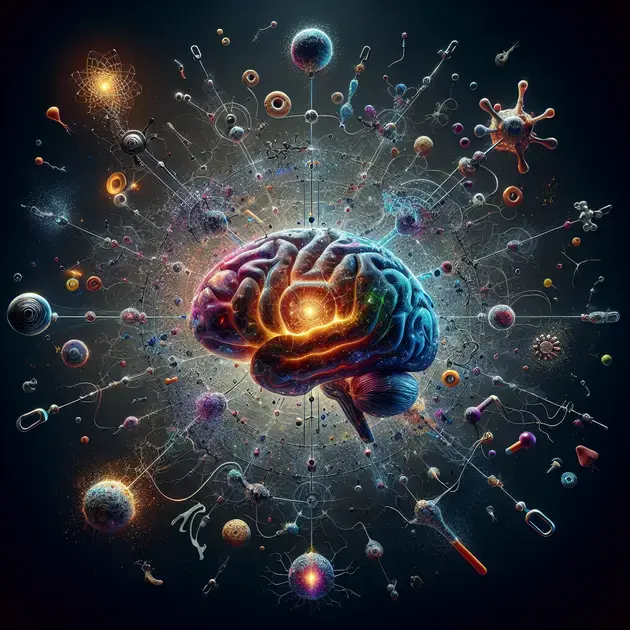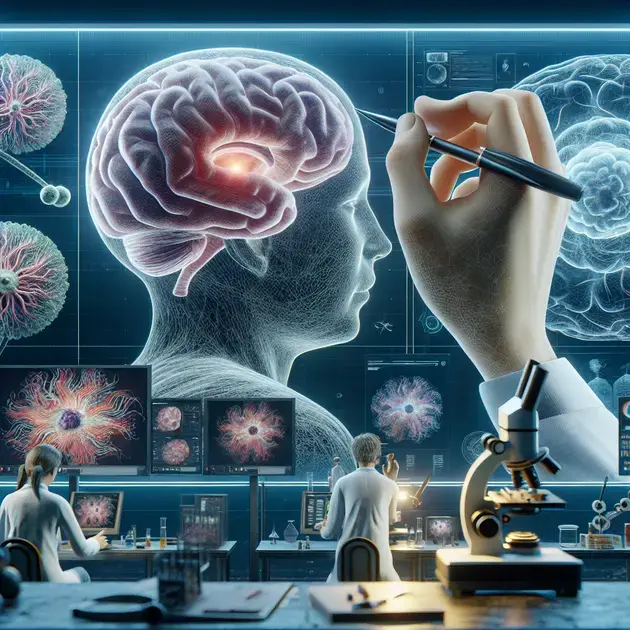The human brain is a fascinating organ, and at the center of it all lies the cerebral cortex. In this post, we will delve into all the intricate details that make up this vital part of the brain, from its structure to its functions. Understanding the complexities of the cerebral cortex can provide us with valuable insights into how we think, learn, and perceive the world around us.
Recent studies have shown that the cerebral cortex is not only responsible for higher brain functions such as thinking and decision-making but also plays a crucial role in memory formation and emotional regulation. As we unravel the mysteries of this intricate neural network, we gain a deeper appreciation for the incredible capabilities of the human brain. Join us on this journey as we explore all about the intricacies of the cerebral cortex and uncover the secrets hidden within its folds.

Unveiling the Anatomy of the Cerebral Cortex
The cerebral cortex is a vital part of the brain responsible for various functions such as memory, attention, perception, awareness, thought, language, and consciousness. To unveil the anatomy of the cerebral cortex, one can explore resources provided by renowned institutions like the Harvard Medical School. They offer online courses and modules that delve deeply into brain anatomy, including the cerebral cortex.
Start by learning about the different regions of the cerebral cortex, such as the frontal lobe, parietal lobe, temporal lobe, and occipital lobe. Understanding the specific functions of each region can provide valuable insights into how the brain processes information and controls various actions.
For a more hands-on approach, consider using virtual reality (VR) tools like the 3D Brain app, which allows users to visualize and interact with a 3D model of the brain, including the cerebral cortex. This immersive experience can enhance your understanding of the anatomy of the cerebral cortex and its significance in cognitive processes.
By exploring online resources, engaging in interactive learning tools, and studying the intricate details of the cerebral cortex, you can deepen your knowledge and appreciation of this essential part of the brain.
Exploring the Functions of the Cerebral Cortex
The cerebral cortex plays a crucial role in processing sensory information, motor functions, and higher cognitive processes. To explore the functions of the cerebral cortex, one can reference textbooks like “Principles of Neural Science” by Eric Kandel, which provides comprehensive insights into the brain’s functions.
Begin by understanding how the cerebral cortex is involved in sensory perception, motor coordination, language processing, and executive functions. Websites like Neuroscience for Kids offer interactive activities and explanations that can help elucidate the diverse functions of the cerebral cortex.
For a practical understanding, consider downloading brain-training apps like Lumosity, which are designed to stimulate different areas of the brain, including the cerebral cortex. These apps offer games and exercises that target memory, attention, and problem-solving skills, providing a fun and educational way to explore cognitive functions.
By delving into academic resources, engaging in interactive platforms, and utilizing brain-training apps, you can deepen your understanding of how the cerebral cortex influences various cognitive processes and behaviors.
Unlocking the Mysteries of Cerebral Cortex Functions
The mysteries of cerebral cortex functions continue to fascinate neuroscientists and researchers worldwide. To unlock these mysteries, one can explore cutting-edge research papers published in journals like Nature Neuroscience, which delve into the latest discoveries and advancements in understanding the cerebral cortex.
Start by investigating the neural circuits and connectivity patterns within the cerebral cortex that underlie complex cognitive functions like decision-making, memory encoding, and emotional regulation. Online databases such as the Allen Brain Atlas provide detailed information on gene expression patterns and neural connections within the cerebral cortex.
For a hands-on approach, consider participating in neuroimaging studies or brain mapping projects that aim to unravel the intricate functions of the cerebral cortex. Institutions like the Human Connectome Project offer opportunities for volunteers to contribute to mapping the brain’s connectivity and functions.
By staying updated on the latest research findings, leveraging online databases for in-depth analysis, and actively participating in brain research initiatives, you can contribute to unlocking the mysteries of cerebral cortex functions and advancing our knowledge of the brain’s complexities.

Diving Deep into Cerebral Cortex Development
In the realm of neuroscience, the intricate process of cerebral cortex development is a captivating subject that continues to intrigue researchers. The cerebral cortex is responsible for higher brain functions such as thought, reasoning, and perception. During embryonic development, the cerebral cortex undergoes a complex series of events that ultimately shape its structure and function. Understanding the mechanisms behind cortical development can provide valuable insights into neurodevelopmental disorders and cognitive processes.
One key aspect of cerebral cortex development is neurogenesis, the process by which neurons are generated from neural stem cells. This process begins early in embryonic development and continues throughout life, albeit at a slower pace. Neuronal migration is another crucial stage, where newly formed neurons travel to their designated locations within the cortex. Disruptions in these processes can lead to structural abnormalities and functional deficits.
Synaptogenesis, the formation of synaptic connections between neurons, is also vital for cerebral cortex development. These connections enable communication between neurons and are essential for learning and memory. As the cortex matures, synaptic pruning occurs, eliminating weaker connections and strengthening important ones. This process is essential for refining neural circuits and optimizing cognitive function.
Environmental factors play a significant role in shaping cerebral cortex development. Stimulating environments rich in sensory experiences can enhance neuronal connectivity and promote neuroplasticity. Conversely, adverse experiences or exposure to toxins can disrupt normal cortical development, leading to long-term consequences. Understanding how environmental influences interact with genetic factors is crucial for unraveling the complexities of cortical development.
In conclusion, delving into the intricacies of cerebral cortex development unveils the remarkable complexity and adaptability of the brain. By uncovering the mechanisms that govern cortical development, researchers can enhance our understanding of neurodevelopmental processes and potentially devise interventions for neurological disorders.
Understanding the Role of Neuroplasticity in the Cerebral Cortex
Neuroplasticity, the brain’s remarkable ability to reorganize and adapt in response to experiences, is a fundamental feature of cerebral cortex function. This phenomenon allows the cortex to adapt to changing environments, learn new skills, and recover from injuries. Understanding the mechanisms underlying neuroplasticity is crucial for unlocking the brain’s potential for growth and recovery.
One key aspect of neuroplasticity is synaptic plasticity, the ability of synapses to strengthen or weaken in response to activity. This process underlies learning and memory formation and is essential for neural communication. Long-term potentiation (LTP) and long-term depression (LTD) are mechanisms that contribute to synaptic plasticity and play a significant role in shaping cortical connectivity.
Experience-dependent plasticity is another vital component of neuroplasticity, where changes in neural circuits occur in response to specific experiences. Sensory input, cognitive tasks, and environmental enrichment can induce structural and functional changes in the cortex. This adaptability enables the brain to optimize its function based on the demands of the environment.
Neuroplasticity also plays a crucial role in recovery from brain injuries and neurological disorders. Through rehabilitation and targeted interventions, individuals can harness the brain’s plasticity to rewire damaged circuits and regain lost functions. Techniques such as constraint-induced movement therapy and cognitive training leverage neuroplasticity to promote recovery and improve quality of life.
Overall, neuroplasticity underscores the brain’s capacity for change and adaptation throughout life. By understanding the mechanisms of neuroplasticity, researchers can develop innovative strategies to enhance learning, promote recovery from brain injuries, and combat neurodegenerative disorders.
Analyzing the Impact of Cerebral Cortex Disorders
Cerebral cortex disorders encompass a wide range of conditions that affect the structure and function of the brain’s outer layer. These disorders can manifest in various ways, leading to cognitive impairments, motor deficits, and sensory disturbances. Understanding the impact of cerebral cortex disorders is crucial for diagnosis, treatment, and management of these conditions.
One common cerebral cortex disorder is epilepsy, a neurological condition characterized by recurrent seizures. Seizures originate from abnormal electrical activity in the cortex and can disrupt normal brain function. Individuals with epilepsy may experience seizures of varying severity, affecting their quality of life and cognitive abilities. Treatment options for epilepsy include medications, surgery, and lifestyle modifications.
Neurodevelopmental disorders such as autism spectrum disorder (ASD) also involve abnormalities in the cerebral cortex. Individuals with ASD may exhibit difficulties in social interaction, communication, and repetitive behaviors. The underlying neurobiological alterations in the cortex contribute to the core symptoms of ASD. Early intervention and behavioral therapies are essential for managing ASD and improving outcomes.
Alzheimer’s disease, a progressive neurodegenerative disorder, affects the cerebral cortex and other brain regions involved in memory and cognitive function. The accumulation of amyloid plaques and neurofibrillary tangles in the cortex leads to neuronal loss and cognitive decline. Research efforts focus on understanding the mechanisms of Alzheimer’s disease and developing targeted treatments to slow its progression.
Overall, analyzing the impact of cerebral cortex disorders sheds light on the complexities of the brain and the challenges faced by individuals affected by these conditions. Through research, education, and advocacy, advancements can be made in the diagnosis, treatment, and care of individuals with cerebral cortex disorders.
Conclusion
The journey into understanding cerebral cortex development reveals a world of intricate processes that shape the foundation of higher brain functions. Exploring neurogenesis, neuronal migration, and synaptogenesis showcases the complexity behind the brain’s structure and function. Environmental factors play a significant role, influencing development positively or negatively, highlighting the delicate balance between nature and nurture in shaping cortical outcomes.
Transitioning to neuroplasticity, we witness the brain’s extraordinary ability to adapt, reorganize, and recover from experiences. Synaptic plasticity, long-term potentiation, and experience-dependent plasticity demonstrate the brain’s dynamic nature, emphasizing its potential for growth and resilience. Neuroplasticity not only fosters learning and memory but also serves as a cornerstone for rehabilitation and recovery from brain injuries and disorders.
Analyzing the impact of cerebral cortex disorders sheds light on the challenges individuals face due to conditions like epilepsy, autism spectrum disorder, and Alzheimer’s disease. Understanding the underlying mechanisms and symptoms of these disorders is paramount for effective diagnosis, treatment, and management. Through advancements in research, education, and advocacy, strides can be made in providing better care and support for those affected by cerebral cortex disorders, enhancing their quality of life and well-being.